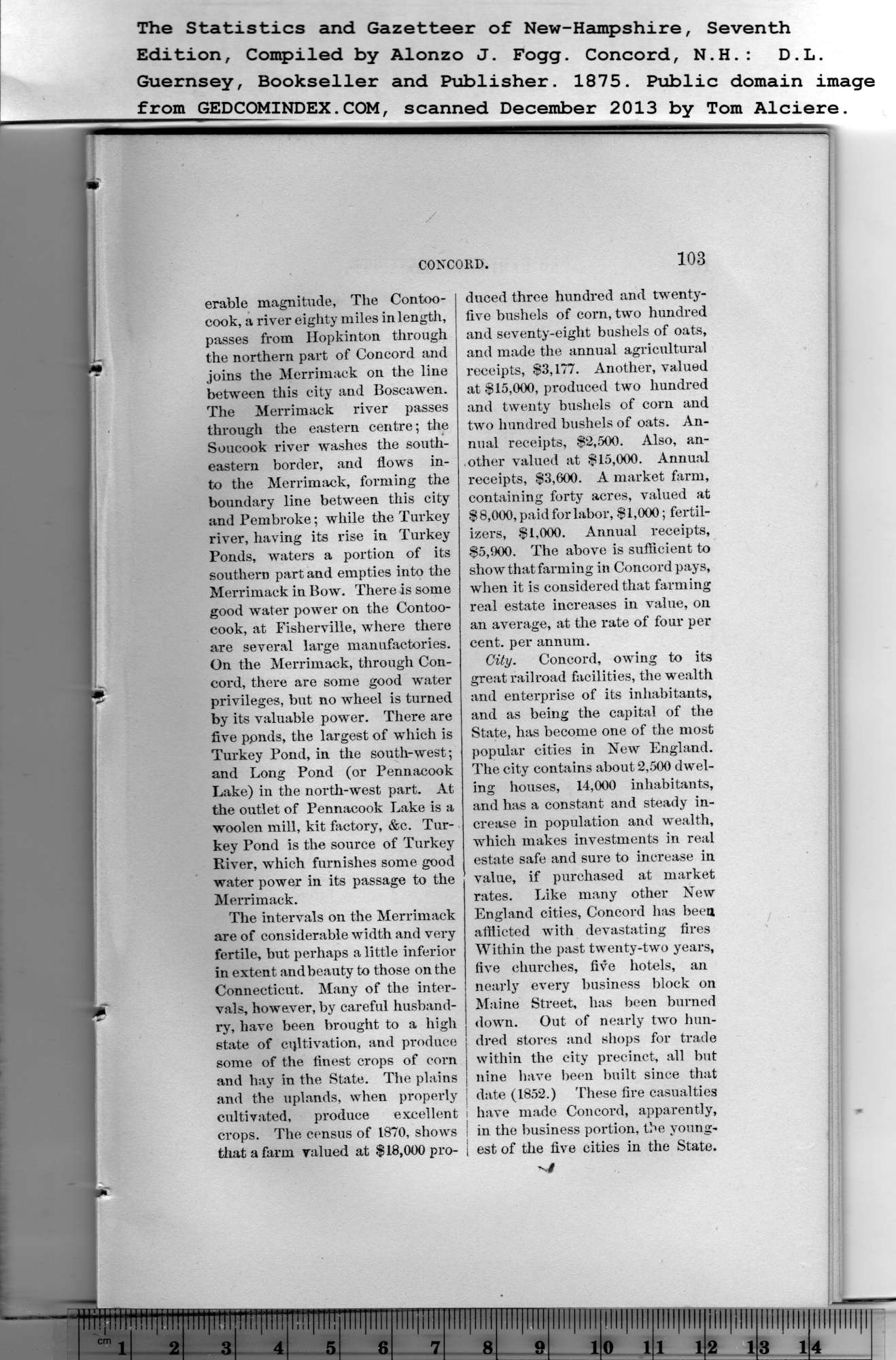|
erable magnitude, The Contoo-
cook, a river eighty miles in length,
passes from Hopkinton through
the northern part of Concord and
joins the Merrimack on the line
between this city and Boscawen.
The Merrimack river passes
through the eastern centre; the
Soucook river washes the south-
eastern border, and flows in-
to the Merrimack, forming the
boundary line between this city
and Pembroke; while the Turkey
river, having its rise in Turkey
Ponds, waters a portion of its
southern part and empties into the
Merrimack in Bow. There is some
good water power on the Contoo-
cook, at Fisherville, where there
are several large manufactories.
On the Merrimack, through Con-
cord, there are some good water
privileges, but no wheel is turned
by its valuable power. There are
five ppnds, the largest of which is
Turkey Pond, in the south-west;
and Long Pond (or Pennacook
Lake) in the north-west part. At
the outlet of Pennacook Lake is a
woolen mill, kit factory, &c. Tur-
key Pond is the source of Turkey
River, which furnishes some good
water power in its passage to the
Merrimack.
|
The intervals on the Merrimack
are of considerable width and very
fertile, but perhaps a little inferior
in extent andbeauty to those on the
Connecticut. Many of the inter-
vals, however, by careful husband-
ry, have been brought to a high
state of cultivation, and produce
some of the finest crops of corn
and hay in the State. The plains
and the uplands, when properly
cultivated, produce excellent
crops. The census of 1870, shows
that a farm valued at $18,000 pro-
duced three hundred and twenty-
five bushels of corn, two hundred
and seventy-eight bushels of oats,
and made the annual agricultural
receipts, $3,177. Another, valued
at $15,000, produced two hundred
and twenty bushels of corn and
two hundred bushels of oats. An-
nual receipts, $‘2,500. Also, an-
other valued at $15,000. Annual
receipts, $3,600. A market farm,
containing forty acres, valued at
$8,000, paid for labor, $1,000; fertil-
izers, $1,000. Annual receipts,
$5,900. The above is sufficient to
show that farming in Concord pays,
when it is considered that farming
real estate increases in value, on
an average, at the rate of four per
cent, per annum.
*~niil|llll}HlltflTT|tIlttlltI11Iti|tHI|liiitlll! Illl|llll|llll|llll|llll|llll|llll|llll|llipi[illl|llll[lll[||||[
ft
City. Concord, owing to its
great railroad facilities, the wealth
and enterprise of its inhabitants,
and as being the capital of the
State, has become one of the most
popular cities in New England.
The city contains about 2,500 dwel-
ing houses, 14,000 inhabitants,
and has a constant and steady in-
crease in population and wealth,
which makes investments in real
estate safe and sure to increase in
value, if purchased at market
rates. Like many other New
England cities, Concord has been
afflicted with devastating fires
Within the past twenty-two years,
five churches, five hotels, an
nearly every business block on
Maine Street, has been burned
down. Out of nearly two hun-
dred stores and shops for trade
within the city precinct, all but
nine have been built since that
date (1852.) These fire casualties
have made Concord, apparently,
in the business portion, the young-
est of the five cities in the State. |
